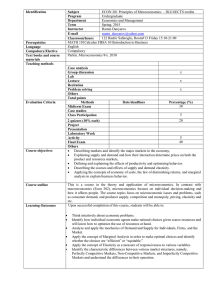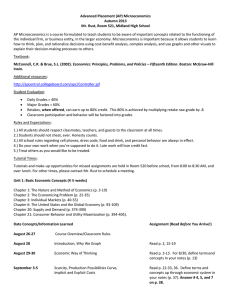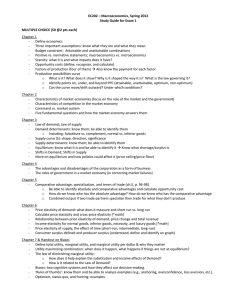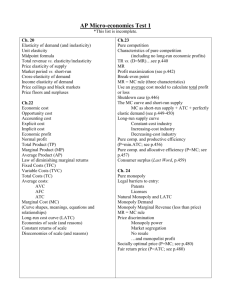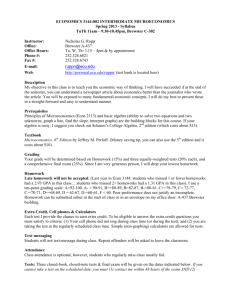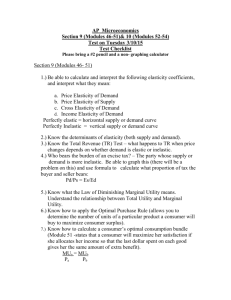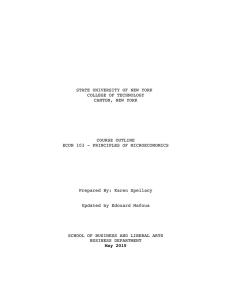principles of microeconomics (econ 202)
advertisement
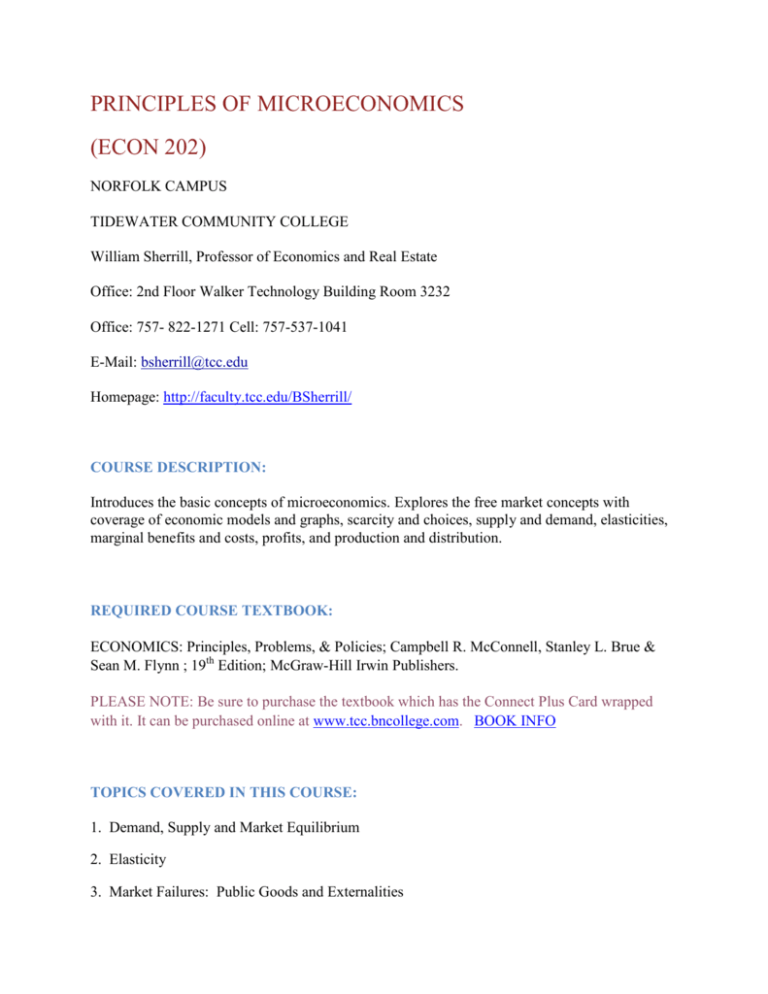
PRINCIPLES OF MICROECONOMICS (ECON 202) NORFOLK CAMPUS TIDEWATER COMMUNITY COLLEGE William Sherrill, Professor of Economics and Real Estate Office: 2nd Floor Walker Technology Building Room 3232 Office: 757- 822-1271 Cell: 757-537-1041 E-Mail: bsherrill@tcc.edu Homepage: http://faculty.tcc.edu/BSherrill/ COURSE DESCRIPTION: Introduces the basic concepts of microeconomics. Explores the free market concepts with coverage of economic models and graphs, scarcity and choices, supply and demand, elasticities, marginal benefits and costs, profits, and production and distribution. REQUIRED COURSE TEXTBOOK: ECONOMICS: Principles, Problems, & Policies; Campbell R. McConnell, Stanley L. Brue & Sean M. Flynn ; 19th Edition; McGraw-Hill Irwin Publishers. PLEASE NOTE: Be sure to purchase the textbook which has the Connect Plus Card wrapped with it. It can be purchased online at www.tcc.bncollege.com. BOOK INFO TOPICS COVERED IN THIS COURSE: 1. Demand, Supply and Market Equilibrium 2. Elasticity 3. Market Failures: Public Goods and Externalities 4. Consumer Behavior 5. Business and the Cost of Production 6. Pure Competition in the Long Run and Short Run 7. Pure Monopoly 8. Monopolistic Competition and Oligopoly 9. Technology, R&D and Efficiency 10. The Demand for Resources 11. Wage Determination 12. Public Finance: Expenditures and Taxes 13. Income Inequality, Poverty and Discrimination LEARNING OUTCOMES: After the completion of this course students will be able to: 1. Relate how supply and demand interact to determine market equilibrium 2. Differentiate between elasticity of demand, elasticity of supply, income elasticity, and cross elasticity. 3. Define and explain the relationship between total utility, marginal utility, and the law of diminishing marginal utility 4. Describe how rational consumers maximize utility 5. Explain why economic costs include both explicit costs and implicit costs 6. Relate the law of diminishing marginal returns to a firm’s short-run production costs 7. Categorize the main characteristics of the four basic market models and identify profit maximizing rates of output for firms in four market structures. 8. Explain how the long run differs from the short run in pure competition 9. Explain how the entry and exit of firms affects resource flows and long-run profits and losses 10. Discuss the economic effects of monopoly 11. Explain the significance of resource pricing 12. Show how wage rates and employment levels are determined in competitive labor markets 13. Demonstrate how monopsony (a market with a single employer) can reduce wages below competitive levels 14. Relate who belongs to U.S. unions, the basics of collective bargaining, and the economic effects of unions 15. Identify three types of market failure and government's role in intervening COURSE REQUIRED ASSESSMENTS: There will be three tests required for this course, plus a quiz on each chapter. Test 1: Chapters: 3-7: Demand, Supply and Market Equilibrium; Elasticity; Consumer Behavior; and Cost of Production Test 2: Chapters 8-11: Market Models (Pure Competition, Pure Monopoly, Monopolistic Competition and Oligopoly) Test 3: Chapters 12, 14, 16, 17, and 20: Microeconomics and Resource Markets; Microeconomics of Government; and Income Inequality, Poverty and Discrimination OTHER FEATURES OF THE COURSE: For additional research and exploration various web-based problems, videos and interactive graphs requiring solutions are also available. GRADING SCALE: A 90 – 100 B 80 – 89 C 79 – 70 D 69 – 60 F 59 AND BELOW OTHER FEATURES OF THE COURSE: For additional research and exploration various web-based problems, videos and interactive graphs requiring solutions are also available. INSTRUCTIONAL PROCEDURES: Teaching activities of this course include: 1. Videos on key economic topics requiring student feedback 2. Writing assignment(s) on an interactive interdisciplinary learning module Please note: If you need course adaptations or accommodations because of a documented disability or if you have medical information that you wish to share, please contact me.

